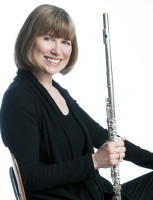Good News Case Study No. 2:
Flutist Nora Shulman
By Eugenia Zukerman
May 31, 2012
 Nora Shulman became the principal flute of the Toronto Symphony Orchestra in 1986. Since then, her career has nearly ended —twice. Shulman suffered hyperextended fingers on her left hand in 1987 and then, 20 years later, slipped on a patch of ice and fractured her left wrist in two places.
Nora Shulman became the principal flute of the Toronto Symphony Orchestra in 1986. Since then, her career has nearly ended —twice. Shulman suffered hyperextended fingers on her left hand in 1987 and then, 20 years later, slipped on a patch of ice and fractured her left wrist in two places.
Having overcome both injuries, Shulman’s career is now more robust than ever. She credits this to the results of hard-won experience, talented medical help, and the customization of her instrument by a creative flute technician.
 Musical America: When was the first accident?
Musical America: When was the first accident?
Nora Shulman: It was in 1987, during a recording session. I was demonstrating something to a colleague and somehow I hyperextended my left hand’s third and fourth fingers. It was a demonstration that went awry. I felt pain, but I kept going and got through the session.
MA: Did you know you had been seriously hurt?
Shulman: I was young, and medically not too savvy. I continued to
have pain. I tried acupuncture for a few months, which helped the
pain, but it did not contribute to healing.
MA: So what finally worked?
Shulman: In 1988, I went to a doctor at the Musicians' Clinics of Canada in Hamilton, Ontario. He ruled out stress fracture and diagnosed an interosseous tear between the middle and ring fingers of my left hand.
MA: What treatment did he prescribe?
Shulman: He recommended a splint, rehabilitation, and rest. But being a workhorse, I kept playing. Musicians are so driven—we’ve learned the music and feel we should be able to perform it. That kind of determination can be dangerous. Finally, in the summer of 1988, I stopped playing.
MA: Sounds wise.
Shulman: I decided to take the entire summer off. I got a medical leave from the orchestra and felt so relieved that I could properly address the injury. I have no regrets, because two wonderful things happened that summer—I took French classes and I got pregnant!
MA: Did you think you’d ever be able to play again?
Shulman: I certainly wanted to. I had stopped playing in June and the orchestra season was to begin again in September. A superb rehab specialist had suggested that I try playing only five minutes at a time, and gradually add a minute a day.
MA: Did it work?
Shulman: Yes! In the six weeks before the Toronto Symphony season began, I slowly, carefully, redeveloped my playing. I came back to the orchestra in good shape, and continued my rehab. However, almost two decades later in 2007, I injured the same hand again.
MA: How?
Shulman: I slipped on the ice and broke my left wrist, fracturing the ulnar and radius bones. Having had an injury that I ignored and simply coped with for a year, I knew that this time I had to put my faith in a process in which healing would be possible.
MA: What process was that?
Shulman: I saw a wonderful hand surgeon. The radical thing he advised was not to have surgery. He felt that casting the hand would eliminate the potential problem of internal scarring. So we casted the hand, and in four weeks the cast came off and was replaced by a splint. I started immediate work with a physiotherapist.
MA: How soon before you were able to play again?
Shulman: It was awhile. My wrist was stiff, and I couldn’t bring my hand around to get my fingers close enough to the left-hand flute keys. I went to a brilliant, resourceful instrument repairman, Jay Gemmill, who built out my left hand keys to extend into a more congenial position for my hand. My surgeon and physiotherapist were monitoring me very closely, and I started to play again, carefully and slowly.
MA: Sounds like a win-win.
Shulman: Rehab is a wonderful thing. It can be uncomfortable, but the practitioners are so important for the process of healing. Once I could get my fingers into better positions, Jay would move the keys back a little bit and eventually the flute was normalized. My playing came back quickly.
MA: How quickly?
Shulman: I broke my wrist on March 4, 2007, and on May 26, 2007, I played a concerto, the beautiful Divertimento for Flute and Strings by John Weinzweig.
MA: Do you have any advice for colleagues who might be dealing with an injury or movement disorder?
Shulman: I think the most important piece of advice is to face your injury and acknowledge that you have a problem. Find really good medical advice and care and don’t stress over the time it will take to heal. Just do it well and slowly. I came back full time from both injuries and I still spend at least 30 to 45 minutes warming up, really slowly. It’s the logical, sensible thing to do.
Nora Shulman Photo: Sian Richards
 Eugenia Zukerman, flutist, is also a writer, arts administrator, TV journalist, educator, and Internet entrepreneur ( ClassicalGenie.com). In demand worldwide as a soloist with orchestras, as a recitalist, and as a chamber-music player, she has recorded more than 20 CDs. As a writer, she has published two novels and two non-fiction books, and from 1998 to 2010 she was the artistic director of the Vail Valley Music Festival in Vail, Colorado. In the summer of 2011 she performed at the Verbier Festival in Switzerland, where she also created Eugenia Zukerman’s Verbier Vlog for MusicalAmerica.com.
Eugenia Zukerman, flutist, is also a writer, arts administrator, TV journalist, educator, and Internet entrepreneur ( ClassicalGenie.com). In demand worldwide as a soloist with orchestras, as a recitalist, and as a chamber-music player, she has recorded more than 20 CDs. As a writer, she has published two novels and two non-fiction books, and from 1998 to 2010 she was the artistic director of the Vail Valley Music Festival in Vail, Colorado. In the summer of 2011 she performed at the Verbier Festival in Switzerland, where she also created Eugenia Zukerman’s Verbier Vlog for MusicalAmerica.com.
Copyright © 2025, Musical America